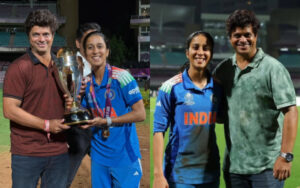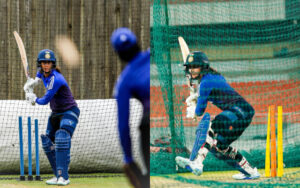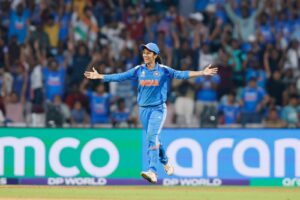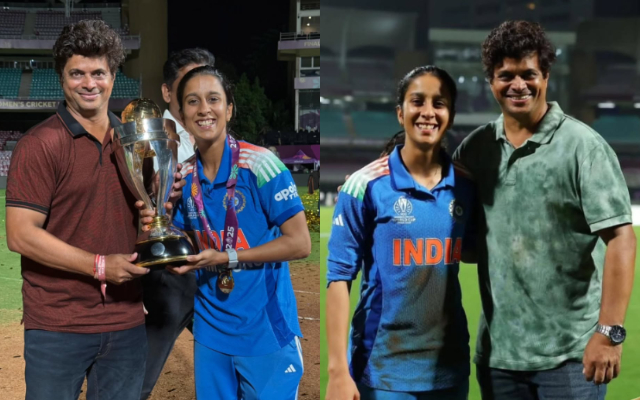
Team India scripted history at the DY Patil Stadium by clinching their maiden ICC Women’s Cricket World Cup title on November 2, 2025. Behind that triumph, one of the key catalysts was Jemimah Rodrigues.
To celebrate her success, RevSportz had an exclusive chat with her coach and mentor, Prashant Shetty, a former Ranji Trophy player, BCCI-certified coach, and the man behind the Kkalpavriksha Cricket Clinic, previously associated with MIG Club, Mumbai.
In this conversation, Prashant opens up on Jemimah’s journey, her match-winning knock against Australia, getting dropped midway into the tournament, technical adjustments, leadership chances in WPL 2026, and more.
Jemimah, the World Champion — how does it feel for you?
It is amazing. That semifinal innings was fantastic because we knocked the seven-time champions out. Then to go on and win the final with that energy, it was just brilliant. The confidence from beating Australia gave a big boost. It is an amazing feeling not just for us, but for the whole country.
For More Exciting Articles: Follow RevSportz
Where and how did the coach-student working relationship begin?
It started about 16 years ago when she was nine. Her brother was already at the MIG Cricket Academy, and her parents asked us to take a look at her, too. The very first ball she faced, she hit a cover drive, and we instantly knew she was special.
We watched her for ten minutes and were convinced she had serious talent. We told her parents to encourage her to pursue cricket, even though she was also playing hockey and football at the time. She clearly had something unique.
There is a viral video of you training Jemimah just before the World Cup with different weight balls. What was the idea behind that?
During the Mumbai monsoon, we cannot practice outdoors, so we train indoors. Since the surface cannot change, we vary the weight of the balls to create new challenges.
For someone like Jemimah, an international cricketer, we need to keep sessions fresh and tough. Using different weights helps her adjust bat-speed, timing, and balance and keeping her sharp.
Jemimah had a tough start to the World Cup — two ducks and a few starts. But she could not convert those starts into scores of substance. Did you speak to her then?
No, not at that stage. We both know there are ups and downs. She has faced tough times before and knows how to fight back. I just encouraged her. But yes, we had a long chat after she was dropped against England.
Were you surprised by that decision?
Yes, nobody expected her to be dropped. I told her she still has every chance to return to the XI if the team changes its combination.
The key was to stay ready because if you get picked again and are not mentally prepared, you waste the opportunity. So, we focused on what was in her control. She trained hard in the nets, believing she would play again.
Then came the New Zealand match, she was picked and batted at No. 3, scored runs, and her confidence returned. That innings gave the team the option of using her as the No. 3 batter.

Her unbeaten 127 against Australia in the semifinal — how special was that?
Probably, that was the innings of a lifetime. We had targeted the knockout games — that’s where champions step up. Before the World Cup, we spoke about past chases where India faltered, especially against Australia, trying to finish too early.
This time, my message was simple: stay till the end. Even if 20–25 runs are needed in the last overs, the pressure shifts to them.
She showed patience, belief and maturity. Even as partners kept changing, she trusted them and guided them. Battling fatigue, showing self-belief — it was an outstanding, mentally tough performance.
After that game, Jemimah opened up about anxiety issues. From a player’s perspective, how do you look at it from a mental side of things?
When you start a tournament with good form but suddenly get two ducks and are dropped, it is hard. Expectations from yourself, your teammates, and fans can be overwhelming. That is when anxiety hits.
It was brave of her to speak about it publicly. It takes courage to show emotions in front of the world, and she deserves credit for that.
Jemimah and Smriti Mandhana share a strong bond. How do you see it?
They have always been close on and off the field. After 6–7 years of international cricket together, you understand each other deeply. In tough times, your best friend steps up. Smriti’s support meant a lot, and Jemimah’s acknowledgement of that shows their unbreakable bond.

What technical changes has Jemimah made recently?
I always felt she needed an initial movement, which she never had earlier. Bowlers began targeting her body and middle stump to avoid her cover drives, shots like cuts, backfoot punches outside of the off stump.
So, we worked on a slight front-toe opening to help her play on the onside better. Over the past year, her onside game has improved significantly; even that first boundary in the semifinal was a flick shot. There is still more to refine, but she is adapting beautifully.
About her sweep shot — she got out a few times playing it. Did you discuss it with her?
No, because even defensive shots can get you out. It was just a misjudgment of length. The sweep is one of her biggest scoring options, one of the best in the world at it.
We never told her to stop playing it. If you have a unique strength, you stick to it. Yes, you will fail sometimes, but you will also dominate bowlers when it comes off.
Should Jemimah continue batting at No. 3 or is she better suited to playing at No. 5?
The debate is over, done and dusted. The way she has played at No. 3 proves she is perfect for that position. She has handled the pressure in different situations. Against New Zealand, she scored when she came out with 17 overs remaining.
Then, in the semi-final against Australia, she came out to bat in the second over and chased down the big total. Even in the final against South Africa, she played smartly on a tough pitch where the ball was not coming onto the bat.
So, what more does she need to prove that she is a good No. 3 batter? I think the debate is done and dusted now. She should bat at No. 3 in both white-ball formats. In red-ball, she needs to bat at No. 4. If she performs consistently there, India can have a lot of chances to win more games.
Jemimah is known for her fielding prowess. What work goes into her fielding drills?
Interestingly, we have never done fielding drills during our sessions. She hardly gets time, always on tours or in franchise cricket. So, we focus on skills and batting.
She gets enough fielding practice in India camps or domestic games. She is naturally athletic and throws herself around, so we use our limited time to polish her batting or even her bowling.

So, can we see more of Jemimah the bowler?
(Laughs) Hopefully! We are hoping that the captains and the coaches actually give her bowling. Maybe she will have to captain India to give herself a few overs. But jokes apart, we are working on her bowling too. She is also passionate about her bowling, but it is mostly about improving her batting skills whenever we get some time.
Jemimah has been retained by Delhi Capitals for WPL 2026. In the backdrop of Meg Lanning not being retained, could she be the next captain?
Hard to say right now. If Meg Lanning enters the auction and DC uses the Right-to-Match card to get her, she might lead again. But if not, in all probability, I feel Jemimah will be the captain. So, fingers crossed. Either way, whatever happens will be for the good.
Also Read: Key stats and records from ICC Women’s World Cup 2025





